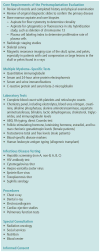The role of high-dose chemotherapy supported by hematopoietic stem cell transplantation in patients with multiple myeloma: implications for nursing
- PMID: 17723970
- PMCID: PMC4201373
- DOI: 10.1188/07.CJON.579-589
The role of high-dose chemotherapy supported by hematopoietic stem cell transplantation in patients with multiple myeloma: implications for nursing
Abstract
Multiple myeloma (MM), a neoplastic proliferation of plasma cells originating from the B-cell line, is associated with deleterious complications and poor outcomes. The failure of conventional combination chemotherapies to improve the overall survival of patients with MM has led to the use of high-dose chemotherapy supported by stem cell transplantation (SCT). Although several novel therapies have emerged since the late 1990s, their survival benefits are undetermined. High-dose chemotherapy with SCT provides better response rates compared to conventional chemotherapy and yields a trend toward greater survival benefits, especially with the use of a tandem (two successive) transplantation strategy. This article discusses standard SCT in patients with MM and some of the new transplantation strategies, including tandem autologous SCTs and reduced-intensity nonmyeloablative allogeneic SCT, and their implications for nursing.
Figures




Similar articles
-
Controversy in multiple myeloma transplants: tandem autotransplants and mini-allografts.Bone Marrow Transplant. 2001 Oct;28(8):725-35. doi: 10.1038/sj.bmt.1703254. Bone Marrow Transplant. 2001. PMID: 11781623 Review.
-
Effects of induction with novel agents versus conventional chemotherapy on mobilization and autologous stem cell transplant outcomes in multiple myeloma.Leuk Lymphoma. 2010 Feb;51(2):243-51. doi: 10.3109/10428190903480728. Leuk Lymphoma. 2010. PMID: 20038230 Free PMC article.
-
The role of high-dose chemotherapy in the treatment of multiple myeloma: a controversy.Ann Oncol. 2000;11 Suppl 1:55-8. Ann Oncol. 2000. PMID: 10707780 Review.
-
Early harvest and late transplantation as an effective therapeutic strategy in multiple myeloma.Bone Marrow Transplant. 1999 Feb;23(3):221-6. doi: 10.1038/sj.bmt.1701559. Bone Marrow Transplant. 1999. PMID: 10084252
-
[Role of stem cell transplantation in treatment of multiple myeloma].Nihon Rinsho. 2007 Dec;65(12):2338-44. Nihon Rinsho. 2007. PMID: 18069280 Review. Japanese.
Cited by
-
Analysis of the feasibility of early hospital discharge after autologous hematopoietic stem cell transplantation and the implications to nursing care.Rev Bras Hematol Hemoter. 2014 Jul-Aug;36(4):264-8. doi: 10.1016/j.bjhh.2014.05.003. Epub 2014 May 29. Rev Bras Hematol Hemoter. 2014. PMID: 25031165 Free PMC article.
-
Evidence-based guidelines for physiotherapy management of patients with multiple myeloma: study protocol.Syst Rev. 2018 Aug 16;7(1):118. doi: 10.1186/s13643-018-0785-7. Syst Rev. 2018. PMID: 30111363 Free PMC article.
-
Stem cell therapies in the clinic.Bioeng Transl Med. 2025 Feb 4;10(3):e70000. doi: 10.1002/btm2.70000. eCollection 2025 May. Bioeng Transl Med. 2025. PMID: 40385529 Free PMC article. Review.
References
-
- Alessandrino EP, Benasconi P, Caldera D, Colombo A, Bonfichi M, Malcovai L, et al. Adverse events occurring during bone marrow or peripheral blood progenitor cell infusion: Analysis of 126 cases. Bone Marrow Transplantation. 1999;23:533–537. - PubMed
-
- American Association of Blood Banks, America’s Blood Centers, American Association of Tissue Banks, American Red Cross, American Society for Apheresis, American Society for Bone and Marrow Transplantation, et al. Circular of information for the use of cellular products. 2005 Retrieved October 27, 2006, from http://www.aabb.org/Documents/About_Blood/Circulars_of_Information/coi_c....
-
- Attal M, Harousseau JL, Facon T, Guilhot F, Doyen C, Fuzibet JG, et al. Single versus double autologous stem-cell transplantation for multiple myeloma. New England Journal of Medicine. 2003;349:2495–2502. - PubMed
-
- Attal M, Harousseau JL, Stoppa AM, Sotto JJ, Fuzibet JG, Rossi JF, et al. A prospective randomized trial of autologous bone marrow transplantation and chemotherapy in multiple myeloma. Intergroupe Francais du Myelome. New England Journal of Medicine. 1996;335:91–97. - PubMed
-
- Badros A, Barlogie B, Siegel E, Cottler-Fox M, Zangari M, Fassas A, et al. Improved outcome of allogeneic transplantation in high-risk multiple myeloma patients after nonmyeloablative conditioning. Journal of Clinical Oncology. 2002;20:1295–1303. - PubMed
Publication types
MeSH terms
Grants and funding
LinkOut - more resources
Full Text Sources
Medical
